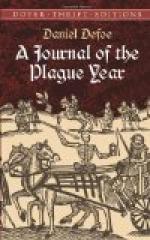“He is a middle-aged, spare man, about forty years old, of a brown complexion, and dark-brown colored hair, but wears a wig; a hooked nose, a sharp chin, gray eyes, and a large mole near his mouth.”
In the years 1720-21 the plague, which had not visited Western Europe for fifty-five years, broke out with great violence in Marseilles. About fifty thousand people died of the disease in that city, and great alarm was felt in London lest the infection should reach England. Here was a journalistic chance that so experienced a newspaper man as Defoe could not let slip. Accordingly, on the 17th of March, 1722, appeared his “Journal of the Plague Year: Being Observations or Memorials of the most Remarkable Occurrences, as well Publick as Private, which happened in London during the Last Great Visitation in 1665. Written by a Citizen who continued all the while in London. Never made public before.” The story is told with such an air of veracity, the little circumstantial details are introduced with such apparent artlessness, the grotesque incidents are described with such animation, (and relish!) the horror borne in upon the mind of the narrator is so apparently genuine, that we can easily understand how almost everybody not in the secret of the authorship believed he had here an authentic “Journal,” written by one who had actually beheld the scenes he describes. Indeed, we know that twenty-three years after the “Journal” was published, this impression still prevailed; for Defoe is gravely quoted as an authority in “A Discourse on the Plague; by Richard Mead, Fellow of the College of Physicians and of the Royal Society, and Physician to his Majesty. 9th Edition. London, 1744.” Though Defoe, like his admiring critic Mr. Saintsbury, had but small sense of humor, even he must have felt tickled in his grave at this ponderous scientific tribute to his skill in the art of realistic description.
If we inquire further into the secret of Defoe’s success in the “History of the Plague,” we shall find that it consists largely in his vision, or power of seeing clearly and accurately what he describes, before he attempts to put this description on paper. As Defoe was but four years old at the time of the Great Plague, his personal recollection of its effects must have been of the dimmest; but during the years of childhood (the most imaginative of life) he must often have conversed with persons who had been through the plague, possibly with those who had recovered from it themselves. He must often have visited localities ravaged by the plague, and spared by the Great Fire of 1666; he must often have gazed in childish horror at those awful mounds beneath which hundreds of human bodies lay huddled together,—rich and poor, high and low, scoundrel and saint,—sharing one common bed at last. His retentive memory must have stored away at least the outline of those hideous images, so effectively recombined many years later by means of his powerful though limited imagination.




